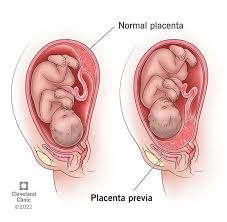A nurse is caring for a client who experienced a vaginal delivery 12 hours ago. When palpating the client's abdomen, at which of the following positions should the nurse expect to find the uterine fundus?
2 cm above the umbilicus
At the level of the umbilicus
One fingerbreadth above the symphysis pubis
To the right of the umbilicus
The Correct Answer is B
The correct answer is choice B. At the level of the umbilicus.
Choice A rationale:
The fundus is typically not found 2 cm above the umbilicus 12 hours postpartum. This position is more common immediately after delivery or in cases of uterine atony or retained placental fragments.
Choice B rationale:
At 12 hours postpartum, the uterine fundus is expected to be at the level of the umbilicus. This indicates normal involution of the uterus, where it contracts and shrinks back to its pre-pregnancy size.
Choice C rationale:
One fingerbreadth above the symphysis pubis is not a typical position for the fundus 12 hours after delivery. This position is more likely several days postpartum as the uterus continues to involute.
Choice D rationale:
The fundus being to the right of the umbilicus may indicate a full bladder, which can push the uterus to one side. This is not a normal finding 12 hours postpartum and would require intervention to empty the bladder.
: https://bchsfoutreach.ucsf.edu/sites/bchsfoutreach.ucsf.edu/files/handouts/Washington%20Hospital%20Postpartum%204-2018.pdf : https://nursekey.com/fundal-palpation-postpartum/
Nursing Test Bank
Naxlex Comprehensive Predictor Exams
Related Questions
Correct Answer is C
Explanation
Choice A reason:
Precipitous labor is characterized by a labor that progresses rapidly and ends within three hours of its onset. It is not typically associated with painless, bright red vaginal bleeding. This condition is more likely to present with intense, frequent contractions and a rapid change in cervical dilation. Therefore, precipitous labor is not the correct answer in this scenario.
Choice B reason:
Abruptio placentae, also known as placental abruption, is a condition where the placenta detaches from the uterus before delivery. It can cause significant maternal and fetal complications. The classic presentation includes painful bleeding, uterine tenderness, and contractions. Given that the scenario describes painless bleeding, abruptio placentae is less likely to be the correct diagnosis.
Choice C reason:
Placenta previa is a condition where the placenta covers the cervix partially or completely. The hallmark sign of placenta previa is painless, bright red vaginal bleeding, which aligns with the scenario provided. This bleeding can occur spontaneously or be triggered by intercourse or a medical exam. Placenta previa is a serious condition that can lead to maternal and fetal hemorrhage and warrants immediate medical attention. Based on the information provided, placenta previa is the most likely diagnosis for the client described.
Choice D reason:
Threatened abortion refers to vaginal bleeding that occurs in the first 20 weeks of pregnancy, which may indicate a potential miscarriage. Since the client is at 36 weeks gestation, threatened abortion is not a relevant diagnosis for late-term bleeding. Additionally, threatened abortion is often accompanied by abdominal cramping, which is not mentioned in the scenario.

Correct Answer is B
Explanation
Choice A Reason:
The recommended intake of iron does not necessarily increase during lactation. In fact, the iron requirement may decrease because menstruation usually ceases, reducing iron loss. However, maintaining adequate iron intake is still important for overall health and to support the baby's growth.
Choice B Reason:
Zinc is crucial for immune function, cell division, and growth, making it an important nutrient during lactation. The recommended dietary allowance (RDA) for zinc for lactating women is indeed higher than for non-pregnant, non-lactating women, with an RDA of about 12 mg per day.
Choice C Reason:
While calcium is important for bone health, the recommended intake for lactating women is not as high as 2,000 mg per day. The RDA for calcium for lactating women is about 1,000 mg per day, similar to that for non-lactating women.
Choice D Reason:
The recommended intake of folic acid does not remain the same as for pregnant women. During pregnancy, the RDA for folic acid is higher to prevent neural tube defects. While folic acid is still important during lactation for cell growth and DNA synthesis, the requirement is slightly lower than during pregnancy.
Whether you are a student looking to ace your exams or a practicing nurse seeking to enhance your expertise , our nursing education contents will empower you with the confidence and competence to make a difference in the lives of patients and become a respected leader in the healthcare field.
Visit Naxlex, invest in your future and unlock endless possibilities with our unparalleled nursing education contents today
Report Wrong Answer on the Current Question
Do you disagree with the answer? If yes, what is your expected answer? Explain.
Kindly be descriptive with the issue you are facing.
